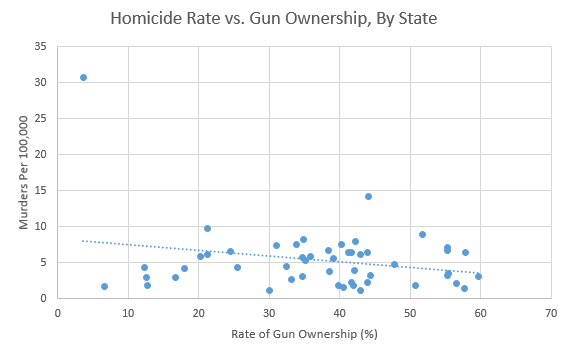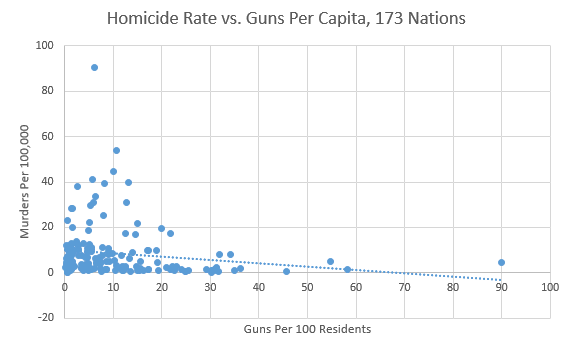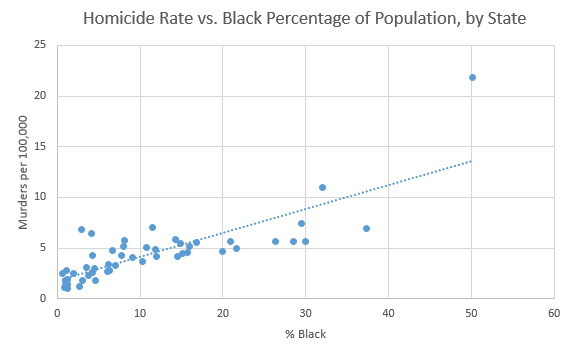A recent exchange on Twitter (another urgent call for gun bans, in reaction to the spree-killing in Charleston) reminded me once again the extent to which gun-control zealots are driven, not by reason and wisdom, but by missionary Utopianism, cultural resentment, naive and sheltered pacifism, and lust for social control. (As someone once said, gun control isn’t about guns, it’s about control.)
In the wake of this mass murder, here are some facts we should keep before us if we wish to examine the issue of gun violence rationally, in the way that a trained engineer would begin diagnosing and fixing a problem:
1) The only thing that stops a spree-killer is armed resistance.
2) Spree-killers know this, and so they seek out “gun-free” zones in nearly every case.
3) Spree killings, however, for all their emotional effect, are only a tiny fraction of gun homicides.
4) If you subtract the gun-homicide rates of America’s violent inner cities, America’s rate falls to European levels.
5) America’s inner cities already have punishingly strict gun laws, yet have staggeringly high rates of gun violence.*
6) There are other places, like Vermont and Switzerland, that have very high rates of gun ownership, and very low rates of gun violence. (Vermont has, effectively, no gun laws at all.)
7) There are hundreds of millions of guns in private ownership in America, and the right to keep and bear them is guaranteed by the Constitution. There is no realistic possibility of making them go away.(*If your response to #5 is to say that guns flow to these places from nearby areas with looser gun laws, then you must explain why homicide rates in those places are so much lower.)
In the comment thread to my January post Degeneracy Pressure, I examined the data on gun-homicide rates and gun ownership, to see if they were correlated. I am reposting some of that comment here.
First I looked at murder rates in the 50 states and Washington, D.C. I scatter-plotted that against the rate of gun ownership in each of these places. Here’s what the resulting graph looks like:

In statistics, correlation can range from -1 to 1; a value of 0 means that there is no correlation at all. The correlation I found for homicide rates vs. gun ownership was moderately negative, at -0.25. This means that states with higher rates of gun ownership are not more, but less likely to have a higher murder rate.
Then I did the same thing worldwide. I looked at homicide rates vs. per-capita gun ownership for 173 nations. Here’s the graph:

As you can see, the trend is still negative. The negative correlation is slightly less, at -0.16. (Getting closer to no correlation at all.)
Looking at the U.S. state-by-state numbers again, however, I did find one thing that correlated extremely well with homicide rates. It’s not something that we are supposed to bring up in decent company, but I’m going to do so anyway. It is the percentage of a state’s population that is black. Here’s the graph for that:

The positive correlation here is very robust: it is 0.81.
If you have a problem and want to solve it, first you have to understand what its causes are. The lack of correlation between gun ownership and gun violence demonstrated above should make it clear that the mere presence of guns is not the root cause of the problem. (I grew up in rural New Jersey, where just about every household owned guns, and we kids all grew up shooting them. We did not, however, shoot one another.)
If the goal is low rates of gun violence, then rather than jumping to the conclusion that the only answer is enhancing government restrictions and prohibitions of gun ownership (when the rate of gun ownership, as demonstrated above, shows no correlation with the desired result), the thing to do is to look at instances in which a low rate of gun violence happens naturally (for example, Vermont and Switzerland). We should then compare these communities with those in which the problem persists despite all attempts to solve it, and persists despite implementing the very solutions that gun-control zealots wish to impose nationwide (e.g., inner-city Detroit and Chicago). We should ask: In what ways do these places differ? This, and only this, will give dependable indications as to the real cause of the problem. Salient factors will emerge, to be controlled for one by one in subsequent analysis.
It may be that what emerges from such analysis does not lend itself comfortably to social-engineering solutions (or may not even be considered acceptable for public discussion). We seem to forget these days that not all complex problems have acceptable or feasible solutions, and that any such solutions as may exist may not involve government action. But as someone who has spent his adult life troubleshooting complex systems, I can say this with confidence: unless and until you understand what really causes a problem, you will never reliably fix it.
10 Comments
Guns, of course, do make their way North to cities with strict gun control laws. Stop and frisk measures were implemented as a means to both clear the streets of illegal guns, as well as their often violent owners. Public sentiment in some quarters – those quarters most affected by the presence of illegal weapons – has turned against stop and frisk measures. Gun-free zones in particular, and municipal gun control in general, are both rendered effectively meaningless. The analysis does not indeed lend itself well to acceptable solutions for gun control advocates. Addressing the disparate impact of gun violence naturally raises questions of race. It is more expedient to avoid these questions, and consequently the analysis as a whole, and seek broad restrictions on gun ownership. Thus, having refused to accept a loss of lliberty in their community (stop and frisk) to resolve a problem within their community (gun violence), these communities choose instead to externalize the cost of lost liberty to society in general, to their benefit in the particular.
(Off topic Malcolm, sorry.
I still have ten digits but next year, if you remember, mind reminding me to always keep cool tubes next to the ones I just used. And to touch ’em just in the offchance I might drop a shell into a hot tube?
I think my hearing’ll be returned by morning. There is a silver lining – I got to the last volley. Last mishap you might recall occurred on the first. No hospital this time though – never knew ’em to be too good with curing acute tinnitus anyway.
Adventures in Arkansas I reckon. Maybe you can plan on joining me next year? I’ll be super careful if you’re here. I promise.)
After some rather profound disagreements re: the Confederate flag and gay marriage, it’s a relief to get back to agreeing on something.
Whoops. Double-posted a comment. You can delete the one in which “Confederate” is misspelled, if you so desire. A grateful nation thanks you.
I must say, though, that your comments function is hilarious. I caught the spelling error after having hit “post comment”; I quickly corrected the error while the Spinning Wheel of Death was still spinning, and when I hit “post comment” again, the comments function shot back, “You’re posting comments too fast. Slow down.” It’s enough to make me wonder whether your comments function was designed by a surly Frenchman.
Kevin, no, it was designed by a well mannered Englishman…I have never been complimented with “you’re posting too fast”.
Glad you agree here, Kevin. (My comments on gay marriage, by the way, were only about the process by which it was made the law of the land.)
“It may be that what emerges from such analysis does not lend itself comfortably to social-engineering solutions (or may not even be considered acceptable for public discussion)”. A generation ago, Daniel Patrick Moynihan learned that the hard way…from members of his own party.
Mr. Larsen nailed it (heh):
“Guns don’t kill people, I kill people.”
gun violence ban is the requirement of today world.
guns law has raised the eyebrow on current government